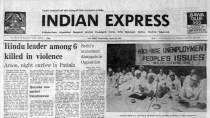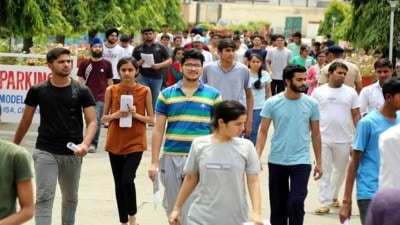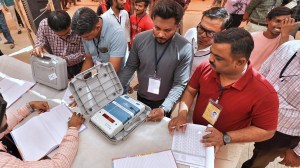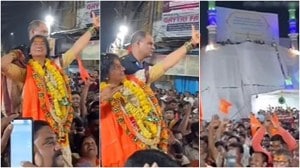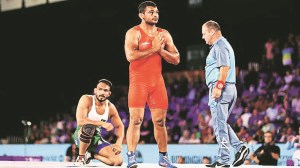- India
- International
As Nepal turns Left, K P Oli will deepen ties with China
KP Oli is also expected to reach out to India to develop some high profile infrastructure projects like Arun 3 and Pancheswar power projects.
 In October, Oli’s CPN-UML and Pushpa Kamal Dahal Prachanda’s Communist Party of Nepal (Maoist Centre) came together to form the Left Alliance. (Source: Reuters)
In October, Oli’s CPN-UML and Pushpa Kamal Dahal Prachanda’s Communist Party of Nepal (Maoist Centre) came together to form the Left Alliance. (Source: Reuters)
We in Nepal are living in interesting times. Prime Minister Sher Bahadur Deuba’s centrist Nepali Congress has received its worst electoral drubbing ever, in a parliamentary election. The country is on the cusp of turning decidedly left.
In a complete pre-election surprise in October, Nepal’s two largest and ever-warring Communist parties came together to cobble the Left Alliance. Two months later, the Alliance is now coasting to comfortable victories in elections to the federal parliament and all but one of the seven provincial assemblies. The Left looks set to win big.
A bevy of Nepali Congress leaders have been roundly beaten: Minister for Information and Communications Mohan Basnet, former Finance Ministers Ram Sharan Mahat and Mahesh Acharya, former Home Ministers Bimalendra Nidhi and Krishna Situala, former Foreign Minister Prakash Sharan Mahat and a party heavyweight and a member of the illustrious Koirala family, Shekhar Koirala. The list is long. So damaging has been the loss for the Congress, Prime Minister Deuba is the only survivor from his home province in western Nepal.
In all likelihood, K P Sharma Oli, chairman of the Communist Party of Nepal-United Marxist Leninist, or the CPN-UML, will soon succeed Deuba.
That’s hardly news many would say. Nepal, after all, gets a new prime minister every nine months or so. But Oli looks set to be a different kind of prime minister. He will be in office for at least two years, if not five full years. According to Nepal’s new constitution, which came out in 2015, a no-confidence motion cannot be moved against a new head of government for two years. And unlike all other recent governments, which were dependent on a laundry list of parties to stay afloat, Oli’s will rest on a resounding majority of the Left Alliance. The last majority government was in office in 1999.

How did this all come about in a country where hung Parliament has become a new normal, where parties are constantly breaking apart to form tiny breakaway outfits, reflecting confusing and contradictory ideological and political positions?
That’s another interesting piece of news about these elections that took place in two phases, on November 6 and December 7.
In October, Oli’s CPN-UML and Pushpa Kamal Dahal Prachanda’s Communist Party of Nepal (Maoist Centre) came together to form the Left Alliance. The Alliance declared in its manifesto that “stability for prosperity” would be its rallying cry. Sick and tired of frequent changes in government and ugly political shenanigans, the idea of stability has strongly resonated with Nepali voters.
Foreign policy priorities
Yet another major factor that has resonated with the voters is Oli’s handling of relations with India and China. When New Delhi imposed an undeclared border blockade against Nepal in 2015 and 016, Oli signed watershed trade and transit framework agreements with China. For the first time, Nepal could now import its oil from China and use Chinese roads, railways and ports for third-country trade. Though neither of the agreements has translated in substantial gains on the ground yet, the move strongly buttressed Oli’s nationalist credentials in Nepali voters’ eyes. Here was a prime minister who was adept at deft diplomacy when the nation so needed.
Under Oli, cooperation with China on infrastructure development will further deepen but the Left government is also expected to reach out to New Delhi to speed up such projects as Postal Road, Pancheshwor and Arun 3.
Political stability will finally also encourage Chinese President Xi Jinping to consider a visit to Nepal, his first, while Indian Prime Minister Narendra Modi will be keen to start afresh after a dip in the warming relationship following the border blockade. Handling these two most important relationships and safeguarding Nepal’s national interest will be his major foreign policy challenge.
Winning Formula
Of the 165 directly elected seats up for grabs in the federal parliament, CPN-UML already has 76 and leads in five more constituencies. Its electoral partner, the Maoist party, has already taken 34 seats and leads in two more. That’s close to 70 percent, a clear landslide. Prime Minister Deuba’s Nepal Congress, meanwhile, has been relegated to 21 seats.
Proportional Representation (PR) votes are still being counted for 110 more seats in the federal parliament and provincial assemblies. The CPN-UML continues to lead in the PR race as well, with the CPN (Maoist Centre) in the third position after the Nepali Congress. But the Left’s margin of victory is expected to narrow as votes of smaller parties also come into play in the broad PR race.
Nepal has adopted a mixed system of voting. In the First-Past-the-Post race, the winner takes all the votes–as it happens in India and many other democracies. So each voter gets to cast two votes, FPTP and PR, in the elections.
Domestic Challenges
Now that Oli and the Left Alliance have bagged a handsome majority, it will be interesting to see how they handle the contentious issue of Constitution amendment that the Madhes-based parties are demanding. The amendment, among others, is aimed at giving the Madhesi/minority population greater political representation. It is perhaps not lost on Oli that all the top leaders of Madhes-based parties—Upendra Yadav, Mahanta Thakur, Anil Jha and Rajendra Mahato—have been elected and his all-conquering Left Alliance has very fared poorly in Province 2, with a dominant Madhesi population.
While the Oli government is expected to pursue ambitious projects to develop infrastructure–roads, railways and airports and so on–there are fears in various quarters that issues of social justice could get sidelined. For now, Nepalis are relieved that they will finally have a stable government, which has set prosperity as its top priority. But with the Nepali Congress in tatters, the spectre of a very weak opposition and what that means to Nepali democracy also looms large.
40 Years Ago
EXPRESS OPINION
More Explained
Apr 18: Latest News
- 01
- 02
- 03
- 04
- 05











